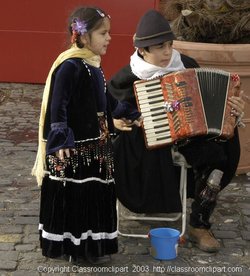Music
|
|
| Contents |
Types of Musical Instruments
Aspects of music
The traditional or classical European aspects of music often listed are those elements given primacy in European-influenced classical music: melody, harmony, rhythm, tone color/timbre, and form. A more comprehensive list is given by stating the aspects of sound: pitch, timbre, intensity, and duration. 4 These aspects combine to create secondary aspects including structure, texture and style. Other commonly included aspects include the spatial location or the movement in space of sounds, gesture, and dance. Silence is also often considered an aspect of music, if it is considered to exist.
As mentioned above, not only do the aspects included as music vary, their importance varies. For instance, melody and harmony are often considered to be given more importance in classical music at the expense of rhythm and timbre. John Cage considers duration the primary aspect of music because it is the only aspect common to both "sound" and "silence."
It is often debated whether there are aspects of music that are universal. The debate often hinges on definitions, for instance the fairly common assertion that "tonality" is a universal of all music may necessarily require an expansive definition of tonality. A pulse is sometimes taken as a universal, yet there exist solo vocal and instrumental genres with free, improvisational rhythms with no regular pulse;5 one example is the alap section of a Hindustani music performance. According to Dane Harwood, "We must ask whether a cross-cultural musical universal is to be found in the music itself (either its structure or function) or the way in which music is made. By 'music-making,' I intend not only actual performance but also how music is heard, understood, even learned." 6
Common terms
Common terms used to discuss particular pieces include note, which is an abstraction which refers to either a specific pitch and/or rhythm or the written symbol; melody, which is a succession of notes heard as some sort of unit; chord, which is a simultaneity of notes heard as some sort of unit; chord progression which is a succession of chords (simultaneity succession); harmony, which is the relationship between two or more pitches; counterpoint, which is the simultaneity and organization of different melodies; and rhythm which is the organization of the durational aspects of music.
See also: List of musical topics.
Production
The music industry is that which creates, performs, and promotes music. A great deal of music is produced by amateurs.
Performance
Someone who performs, composes, or conducts music is a musician. Performance is a method for musicians to share music with others.
Solo and ensemble
Many cultures include strong traditions of solo or soloistic performance, such as in Indian classical music, while other cultures, such as in Bali, include strong traditions of group performance. All cultures include a mixture of both, and performance may range from improvised solo playing for one's enjoyment to highly planned and organized performance rituals such as the modern classical concert or religious processions. What is called chamber music is often seen as more intimate than symphonic works. A performer is called a musician, a group being a musical ensemble such as a rock band or symphony orchestra.
Oral tradition and notation
Music is often preserved in memory and performance only, handed down orally, or aurally ("by ear"). Such music, especially that which has no known individual composer, is often classified as "traditional". Different musical traditions have different attitudes towards how and where to make changes to the original source material, from quite strict, to those which demand improvisation. If the music is written down, it is generally in some manner which attempts to capture both what should be heard by listeners, and what the musician should do to perform the music. This is referred to as musical notation, and the study of how to read notation involves music theory. Written notation varies with style and period of music, and includes scores, lead sheets, guitar tablature, among the more common notations. Generally music which is to be performed is produced as sheet music. To perform music from notation requires an understanding of both the musical style and performance practice expected or acceptable.
Improvisation, interpretation, composition
Most cultures use at least part of the concept of preconceiving musical material, or composition, as held in western classical music. Many but fewer cultures also include the related concept of interpretation, performing material conceived by others, and less still the contrasting concept of improvisation, material which is spontaneously thought of while performed, not preconceived. However, many cultures and people do not have this distinction at all, using a broader concept which incorporates both without discrimination. Improvised music virtually always follows some rules or conventions and even "fully composed" includes some freely chosen material. See also, precompositional. Composition does not always mean the use of notation, or the known sole authorship of one individual.
Music can also be determined by describing a "process" which may create musical sounds, examples of this range from wind chimes, through computer programs which select sounds. Music which contains elements selected by chance is called Aleatoric music, and is most famously associated with John Cage and Witold Lutoslawski. See: precompositional, form (music), modulation, twelve tone technique, serialism, and process music.
Compositions
Musical composition is a term that describes the makeup of a piece of music. Methods of composition vary widely, however in analyzing music all forms -- spontaneous, trained, or untrained -- are built from elements comprising a musical piece. Music can be composed for repeated performance or it can be improvised; composed on the spot. The music can be performed entirely from memory, from a written system of musical notation, or some combination of both. Study of composition has traditionally been dominated by examination of methods and practice of Western classical music, but the definition of composition is broad enough to include spontaneously improvised works like those of free jazz performers and African drummers. What is important in understanding the composition of a piece is singling out its elements. An understanding of music's formal elements can be helpful in deciphering exactly how a piece is made. A universal element of music is time or more generally rhythm. When a piece appears to have no time, it is considered rubato. The Italian term, meaning "free time," does not mean "without rhythm," but rather that the tempo or time of the piece changes dynamically. Even random placement of random sounds, often occurring in musical montage, occurs within some kind of time, and thus employs time as a musical element. Any musical event comprised of elements can be considered a "composition."
Reception and audition
The field of music cognition involves the study of many aspects of music including how it is processed by listeners.
Music is experienced by individuals in a huge variety of social settings ranging from being alone to attending a large concert. Concerts take many different forms and may include people dressing in formal wear and sitting quietly in the rows of auditoriums, drinking and dancing in a bar, or loudly cheering and booing in an auditorium.
Deaf people can experience music by feeling the vibrations in their body; the most famous example of a deaf musician is the composer Ludwig van Beethoven, who composed many famous works even after he had completely lost his hearing. In more modern times, Evelyn Glennie, who has been deaf since the age of twelve, is a highly acclaimed percussionist. Also, Chris Buck, a violinist virtuoso and New Zealander, has recently lost his hearing. See: Baschet Brothers. See: psychoacoustics.
Media
The music that composers make can be heard through several media; the most traditional way is to hear it live, in the presence, or as one of, the musicians. Live music can also be broadcast over the radio or television. Some musical styles focus on producing a sound for a performance, while others focus on producing a recording which mixes together sounds which were never played "live". Recording, even of styles which are essentially live often uses the ability to edit and splice to produce recordings which are considered "better" than the actual performance.
In many cultures there is less distinction between performing and listening to music, as virtually everyone is involved in some sort of musical activity, often communal. In industrialized countries, listening to music through a recorded form, such as sound recording or watching a music video, became more common than experiencing live performance, roughly in the middle of the 20th century. Sometimes, live performances incorporate prerecorded sounds; for example, a DJ uses disc records for scratching.
Audiences can also become performers by using Karaoke, invented by the Japanese, which uses music video and tracks without voice, so the performer can add his voice to the piece.
See: sound sculpture.
Education
Training
Many people, including entire cultures, compose, perform, and improvise music with no training and feel no need for training. Other cultures have traditions of rigorous formal training that may take years and serious dedication. Sometimes this training takes the form of apprenticeship. For example, Indian training traditionally take more years than a college education and involves spiritual discipline and reverence for one's guru or teacher. In Bali, everyone learns and practices together. It is also common for people to take music lessons, short private study sessions with an individual teacher, when they want to learn to play or compose music, usually for a fee. A famous private composition teacher is Nadia Boulanger.
Secondary education
The incorporation of music performance and theory into a general liberal arts curriculum, from preschool to postsecondary education, is relatively common. Western style secondary schooling is increasingly common around the world, such as STSI in Bali. Meanwhile, western schools are increasingly including the study of the music of other cultures such as the Balinese gamelan, of which there are currently more than 200 in America.
Study
Many people also study about music in the field of musicology. The earliest definitions of musicology defined three sub-disciplines: systematic musicology, historical musicology, and comparative musicology. In contemporary scholarship, one is more likely to encounter a division of the discipline into music theory, music history, and ethnomusicology. Research in musicology has often been enriched by cross-disciplinary work, for example in the field of psychoacoustics. The study of music of non-western cultures, and the cultural study of music, is called ethnomusicology.
In Medieval times, the study of music was one of the Quadrivium of the seven Liberal Arts and considered vital to higher learning. Within the quantitative Quadrivium, music, or more accurately harmonics, was the study of rational proportions.
Music theory is the study of music, generally in a highly technical manner outside of other disciplines. More broadly it refers to any study of music, usually related in some form with compositional concerns, and may include physics, mathematics, and anthropology. What is most commonly taught in beginning music theory classes are guidelines to write in the style of the common practice period, or tonal music. Theory, even that which studies music of the common practice period, may take many other forms. Musical set theory is the application of mathematical set theory to music, first applied to atonal music. Speculative music theory, contrasted with analytic music theory, is devoted to the analysis and synthesis of music materials, for example tuning systems, generally as preparation for composition. See "Common Terms" above.
History
The history of music in relation to human beings predates the written word and is tied to the development and unique expression of various human cultures. Popular styles of music varied widely from culture to culture, and from period to period. Different cultures emphasized different instruments, or techniques. Music history itself is the (distinct) subfield of musicology and history, which studies the history of music theory.
See also: Music and politics.
Genres
As there are many definitions for music there are many divisions and groupings of music, many of which are caught up in the argument over the definition of music. Among the larger genres are classical music, popular music or commercial music (including rock and roll), country music and folk music.
There is often disagreement over what constitutes "real" music: Mozart, Stravinsky, serialism, Jazz, hip hop, punk rock, and electronica have all been considered non-music at various times and places.
The term world music has been applied to a wide range of music made outside of Europe and European influence, although its initial application, in the context of the World Music Program at Wesleyan University, was as a term including all possible music genres, including European traditions. (In academic circles, the original term for the study of world music, "comparative musicology", was replaced in the middle of the twentieth century by "ethnomusicology", which is still an unsatisfactory coinage.)
Genres of music are as often determined by tradition and presentation as by the actual music. While most classical music is acoustic and meant to be performed by individuals or groups, many works described as "classical" include samples or tape, or are mechanical. Some works, like Gershwin's Rhapsody in Blue, are claimed by both jazz and classical music.
As world cultures have been in greater contact, their indigenous musical styles have often merged into new styles. For example, the U.S.-American bluegrass style contains elements from Anglo-Irish, Scottish, Irish, German and some African-American instrumental and vocal traditions, and could only have been a product of the 20th Century.
Many current music festivals celebrate a particular musical genre.
Clip Art and Pictures
- Music Clip Art (https://classroomclipart.com/image/category/music-clipart.htm)
- Musical Instruments Clip Art (https://classroomclipart.com/image/category/musical-instruments-clipart.htm)
- Music Clipart Animations (https://classroomclipart.com/image/category/music-animated-clipart.htm)




